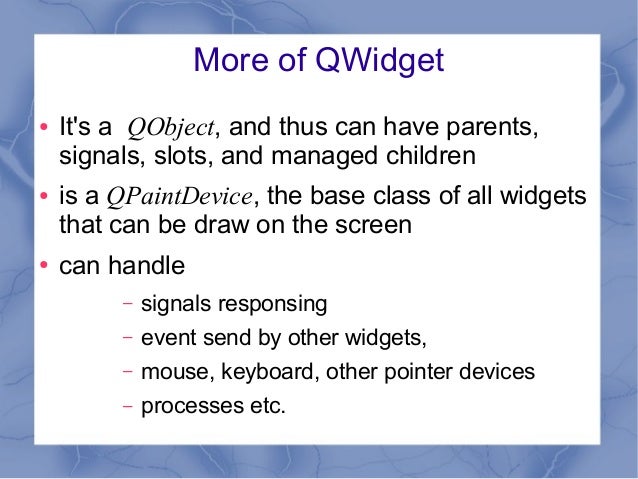Qt Signals And Slots Across Processes
Target Audience: Qt developers wishing to integrate 3d technology in their application.
Aug 07, 2009 I wanted to cite this mailing list question from me about models and views on different threads in Qt (along with the ensuing answers). Rank of suits texas holdem and poker. The qt-interest mailing list entries from 2009 seem to have all but disappeared from the web, but I found this one in an Internet Archive cache off of 'gmane'. While Qt is mainly used to create graphical applications, the Qt API is very extensive and includes data structures, networking, input/output, support for threads and more 7. One notable feature of Qt is its use of a preprocessor, called the Meta-Object Compiler (MOC), to extend the C language with features like signals and slots.
Wgs no deposit bonus codes 2019 download. Collect scatter bonuses and a high paying jackpot.Red Stag Casino Bonusis the latest addition to the Wager Gaming community, and our personal recommendation in terms of graphic design, support and player options.
Qt Connect Signal Slot

Prerequisites: The audience is expected to have familiarity with basic QtQuick and OpenGL concepts, but no in-depth knowledge of them is required.
Description
Starting with the utility and enabler classes (for OpenGL, Vulkan and the upcoming Metal support), we will look at low level support for using OpenGL with QOpenGLWindow for rendering and event handling. We will also look at the support in the Widgets module.
Qt Signal Slot With 2 Arguments
Later we will show the technologies available in Qt that allow deep integration of Qt Quick 2 scenes with custom drawn OpenGL content. We will discuss the possibility of simply providing a Qt Quick overlay for an OpenGL scene. The discussion will then proceed to the creation of custom Qt Quick Items drawn using raw OpenGL commands, which can then be used from QML. We will also illustrate how to manually drive Qt Quick’s own rendering if we need to be in complete control of how and when the rendering happens.
Finally, we will look at Qt 3D and how to use its scene graphs and frame graphs to create high performance 3d rendering without requiring the specialist knowledge required when accessing OpenGL directly. Along the way we will introduce the Qt 3D renderer and input systems and how they are built on top of a flexible, highly threaded, Entity Component System (ECS) architecture that scales very well and is ripe for future additions.
You will learn how:
Qt Signals And Slots Tutorial
- to create windows for 3D rendering
- to add a Qt Quick based UI to an OpenGL application
- to create custom, high-performance Qt Quick Items using OpenGL
- to integrate your own OpenGL renderer with the Qt Quick Renderer
- to construct a basic Qt 3D application
- to make a scene graph, display 3D graphical content using geometry, materials, textures
- Qt 3D maps onto the graphics pipeline
- to extend Qt 3D to use your own custom geometry
- to write custom materials and shaders
- to completely control the Qt 3D renderer dynamically at runtime using the Frame Graph

Trainer: James Turner, KDAB
Senior Software Engineer and team lead at KDAB, James has been developing with Qt since 2002. He contributes to the current maintenance of Mac platform support as well as the development of OpenGL and 3D support in Qt. James has a background in user-interface, graphics and simulation development as well as a long history of development on OS-X and prior versions of Mac OS. He is a lead developer on FlightGear, the open-source flight simulator, and holds a BSc in Computer Science.